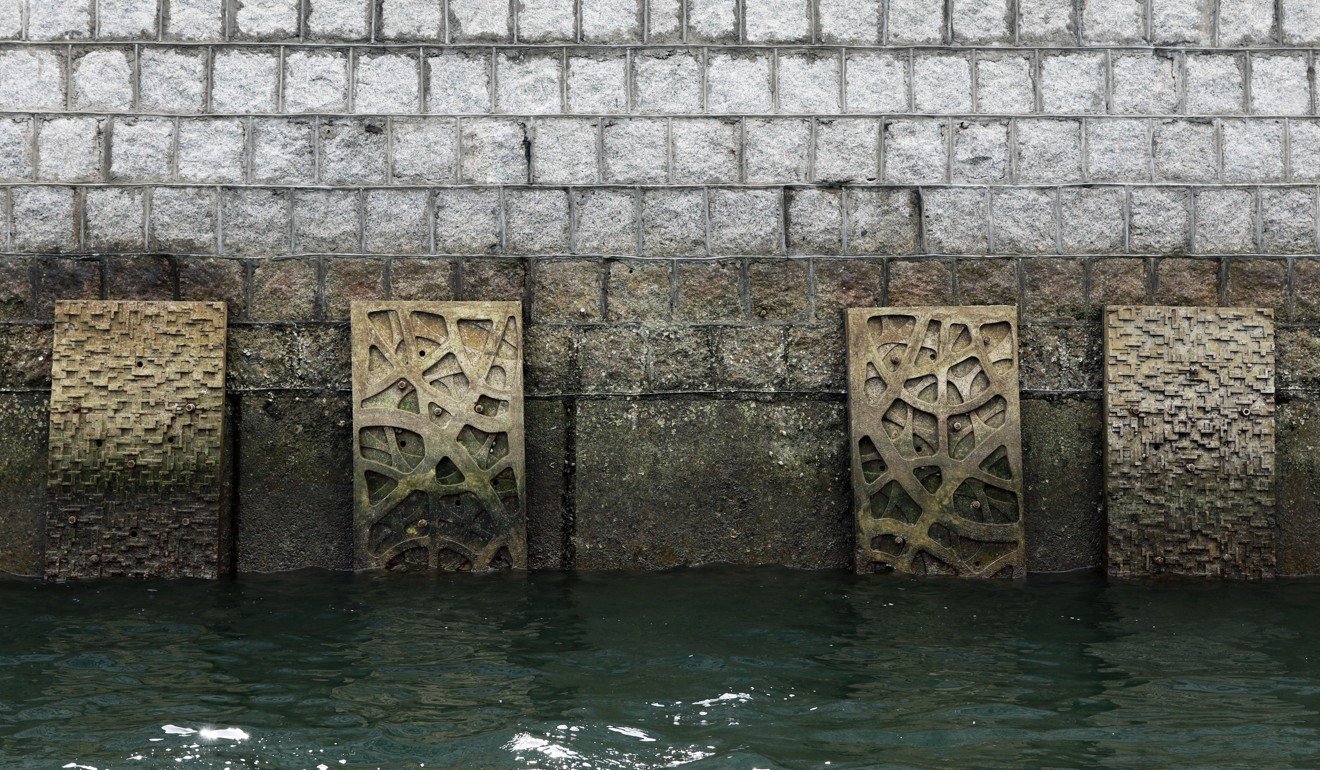
Hong Kong marine ecologists lead ‘eco-shoreline’ project to reshape city’s seawalls and pave the way for future reclamation projects
- Project tests how modifying artificial shorelines boosts biodiversity – and could be template for future reclamation projects.
- Government-funded HK$5 million project to run until 2021
Under a government-funded project, experts at the University of Hong Kong and Polytechnic University are currently testing specially designed, eco-friendly concrete blocks and panels that can be attached to seawalls at three coastal locations in the New Territories.
The panels and blocks have grooves and ridges that mimic rocks eroded by weather and seawater, allowing room for organisms to hide from predators and harsh conditions.
“During midday, temperatures can be as high as above 50 degrees Celsius [on the seawall] and can cook the organisms alive and kill them,” said Kenneth Leung Mei-yee, a professor of aquatic ecology and toxicology at HKU who is leading the project.

After installation is completed in July, the HK$5 million (US$639,942) eco-shoreline project will run until mid-2021.
Researchers hope the two-year trial will prove that concrete tiles and blocks should be retrofitted to the city’s existing 190km reclaimed artificial seawalls and serve as a guide for future reclaimed coastlines.
According to Leung, the concrete surfaces of artificial seawalls in place now are too smooth for algae and microorganisms – a major food source for marine life such as snails and limpets. The result is a break in the food chain: without the smaller species, the seawalls are unable to attract larger marine life and predators.
“The added eco-panels provide shading, with holes and crevasses that have water-holding capacity, so animals can survive. Eventually, these will attract fish, crabs and other animals, making a much enriched ecosystem,” Leung said.
Preliminary findings from a test completed last September in North Lantau and Tuen Mun with similar eco-tiles showed that the number of marine species had doubled to 12, compared to the number of species found on artificial seawalls without the fixtures. The number of species was close to the amount found on natural structures.

The team has attached panels and tide pool blocks on vertical and sloped seawalls at three marine environments – in Ma Liu Shui, Sai Kung and Lung Kwu Tan. Oysters, which are filter feeders, are also deployed in baskets bolted to the rocks to help clean the water and attract more marine life.
Most fixtures are imported from Israel, but researchers are also designing their own eco-tiles. The locally developed fixtures are made with two concrete mixtures comprising sediment dredged from navigation channels, and ash from burned sludge from a local waste-water treatment plant.
“We can kill two birds with one stone – we can minimise the waste problem by up-cycling them to become useful eco-concrete,” Leung said.

Hong Kong’s future depends on reclamation, committee says, as it backs plan for work at six sites
If the Lantau project goes ahead, Leung suggested that officials reserve land to build a wetland park along the coast. He said the potential marine reserve should be planted with mangroves and use eco-blocks to protect the shoreline from storms and attract marine life .
“I’m not promoting reclamation. I think if we have a choice, we shouldn’t do it,” Leung said. “But if the government and citizens think that this is the way forward, [eco-shorelines] may be a mitigation method we should consider.”
He continued: “Natural shorelines have evolved for millions, or even billions of years. There is no way we can completely rebuild or imitate them.”
The Civil Engineering and Development Department, which commissioned the project, said it hoped the findings could provide a scientific basis for the future implementation of eco-shorelines around Hong Kong.

The city’s first eco-shoreline will be built as part of the seawall bordering the Tung Chung new town extension. The HK$175 million seawall, slated for completion in 2023, is expected to shelter about 145,500 people.
Leung, who advised on the eco-shoreline design for Tung Chung, said the coastline would look like stepped terraces made up of eco-blocks, which would allow people to get close to the water.
Vincent Ng Wing-shun, chairman of the Harbourfront Commission, welcomed the project and said he hoped existing seawalls could be upgraded, such as those surrounding the old airport runway in Kai Tak and at the typhoon shelter in Causeway Bay.
Green groups slam task force for downplaying impact of land reclamation
“Hong Kong’s seawalls are designed to be robust from an engineering perspective. But now, it’s time we should also care about sustainability and promoting biodiversity,” Ng said.

After inspecting the Ma Liu Shui trial site where eco-blocks had been installed for three months, Juan Carlos Astudillo, a HKU marine ecologist, said the early results were “quite promising”.
“It’s early to tell, but just from our observations, the units and tidal pools already have tube worms and snails growing there and oysters on the bottom,” Astudillo said.
In contrast, boulders that had been scraped clean and used as a control subject in the experiment were only covered in biofilm – a green layer of marine bacteria and microorganisms.
Leung said he held high hopes for the changes the project might bring.
“These artificial seashores are just like a desert, there’s not much life there. Now, [by modifying them], it’s like planting trees and rivers, so the desert will become an oasis,” he said.

